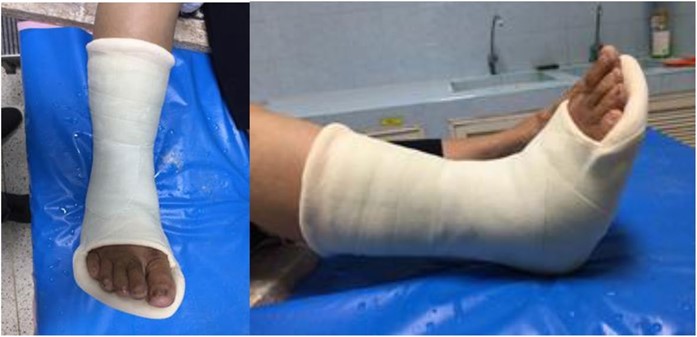A client with a compound fracture of the left ankle is being discharged with a below-the-knee cast. Which
instruction should the practical nurse (PN) provide to the client prior to discharge?
Apply a cold pack to any "hot spots" on the cast.
Keep the left leg in a dependent position.
Expect some increase in pain.
Never scratch under the cast.
The Correct Answer is D
When providing instructions to a client with a below-the-knee cast for a compound fracture of the left ankle, it is important to prioritize their safety and proper care of the cast. The instruction to never scratch under the cast is crucial for preventing complications and maintaining the integrity of the cast.
Let's evaluate the other options:
a) Apply a cold pack to any "hot spots" on the cast.
Applying a cold pack to any "hot spots" on the cast may help alleviate discomfort or itching, but it is not the highest priority instruction. Preventing scratching under the cast is more important to avoid skin damage or infection.
b) Keep the left leg in a dependent position.
Keeping the left leg in a dependent position (hanging down) is not the appropriate instruction for a client with a below-the-knee cast. It is generally recommended to elevate the injured limb to reduce swelling and promote proper blood flow. Elevating the leg would involve keeping it raised above the level of the heart.
c) Expect some increase in pain.
While it is possible for the client to experience some increase in pain after the application of a cast, this instruction alone is not comprehensive or specific enough for proper discharge education. Providing information about pain management strategies or when to seek medical atention for excessive pain would be more appropriate.
In summary, when discharging a client with a compound fracture of the left ankle and a below-the-knee cast, the practical nurse (PN) should provide the instruction to never scratch under the cast. This helps prevent complications and maintain the integrity of the cast, promoting proper healing of the fracture.

Nursing Test Bank
Naxlex Comprehensive Predictor Exams
Related Questions
Correct Answer is B
Explanation
Choice A reason: Encouraging community members to practice fire drills is an activity that is a part of the prevention/mitigation phase of the disaster management cycle because it can reduce the risk of injury or death from fire by increasing the awareness and preparedness of the community.
Choice B reason: Identifying community members who have disabilities is an activity that is a part of the prevention/mitigation phase of the disaster management cycle because it can reduce the vulnerability of these individuals by ensuring that they have access to appropriate resources and assistance in case of a disaster.
Choice C reason: Providing first aid to community members affected by a tornado is not an activity that is a part of the prevention/mitigation phase of the disaster management cycle, but rather the response phase, which involves delivering immediate and short-term assistance to save lives and meet basic needs during and after a disaster.
Choice D reason: Assisting community members in developing a disaster plan is not an activity that is a part of the prevention/mitigation phase of the disaster management cycle, but rather the preparedness phase, which involves enhancing the readiness and capabilities of individuals, organizations, and communities to respond to and recover from a disaster.
Correct Answer is D
Explanation
Choice A reason: Analgesics are not the most effective classification of medications for treating this pain because they are drugs that relieve pain by blocking pain signals or reducing inflammation, but they do not address the underlying cause of trigeminal neuralgia, which is compression or irritation of the trigeminal nervE.
Choice B reason: Antihistamines are not the most effective classification of medications for treating this pain because they are drugs that block histamine receptors and reduce allergic reactions, but they do not affect the function or activity of the trigeminal nervE.
Choice C reason: Antibiotics are not the most effective classification of medications for treating this pain because they are drugs that kill or inhibit bacteria and treat infections, but they do not treat trigeminal neuralgia unless it is caused by a bacterial infection, which is rarE.
Choice D reason: Anticonvulsants are the most effective classification of medications for treating this pain because they are drugs that stabilize nerve membranes and reduce nerve impulses, which can decrease the frequency and intensity of trigeminal neuralgia attacks
Whether you are a student looking to ace your exams or a practicing nurse seeking to enhance your expertise , our nursing education contents will empower you with the confidence and competence to make a difference in the lives of patients and become a respected leader in the healthcare field.
Visit Naxlex, invest in your future and unlock endless possibilities with our unparalleled nursing education contents today
Report Wrong Answer on the Current Question
Do you disagree with the answer? If yes, what is your expected answer? Explain.
Kindly be descriptive with the issue you are facing.
